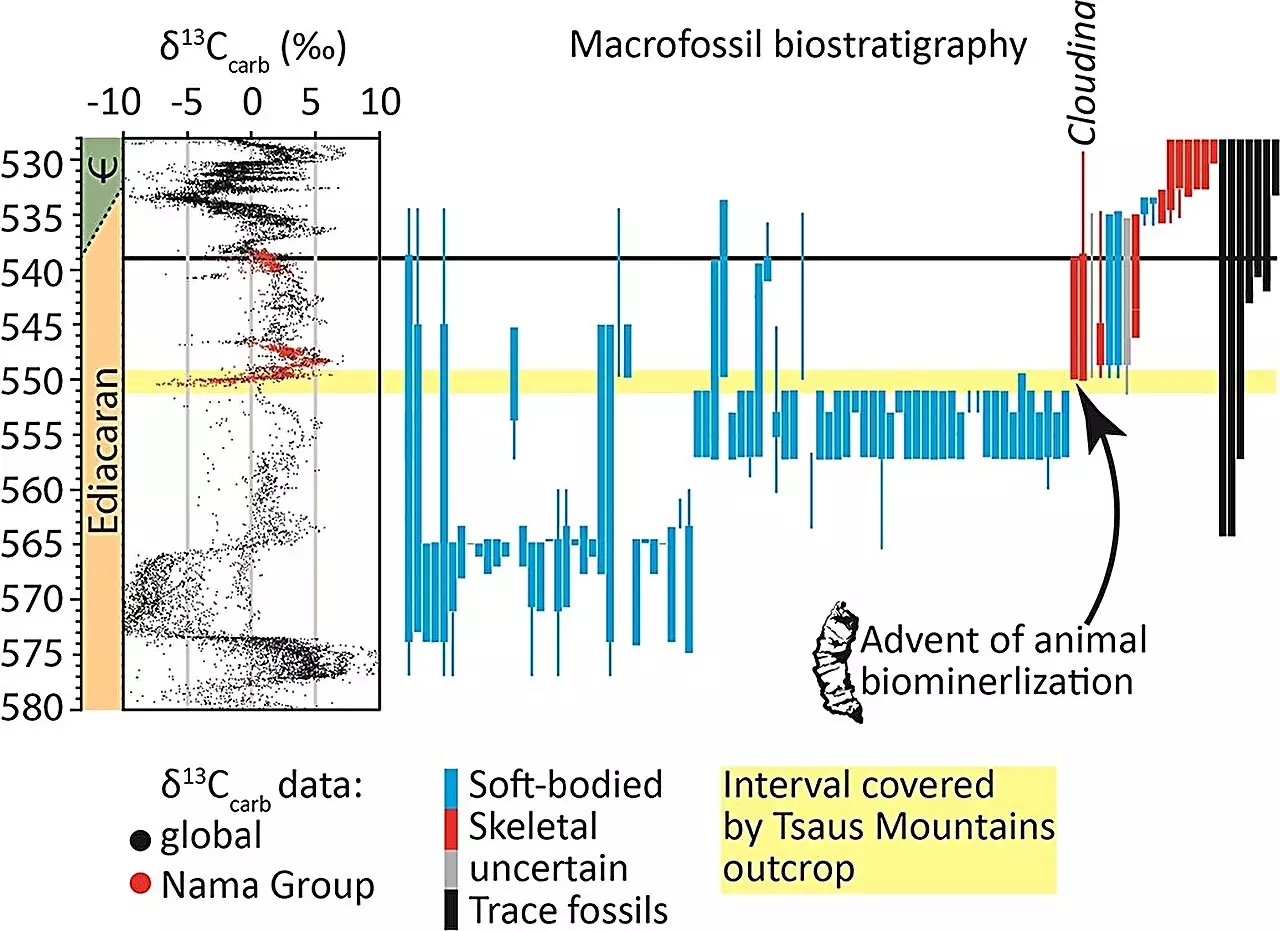Life on Earth has evolved and diversified over billions of years, from single-celled organisms to the complex multicellular organisms we see today. The transformation from simple to multicellular life was made possible by a crucial process called biomineralization. This process involves the production of hardened mineralized tissues, such as skeletons, by living organisms. Not only has biomineralization shaped the vast array of body plans we observe today, but it has also greatly impacted the planet’s carbon cycle.
In the Tsau Khaeb National Park, located in Namibia, fossilized skeletons of cloudinids, known as Cloudina, have been discovered. These tubular structures, composed of carbonate cones measuring up to 1.5cm in length, date back to around 551-550 million years ago in the Ediacaran period (approximately 635-538 million years ago). Dr. Fred Bowyer and his colleagues from the University of Edinburgh sought to investigate the origins of biomineralization on Earth and understand the magnitude of its impact.
The researchers combined sediment analysis with geochemical data, specifically carbon and oxygen isotopes, obtained from limestones in the Kliphoek Member of the Nama Group. These rocks were formed in a shallow sea during a period of low stand before transitioning into open marine conditions. The Nama Group rocks play a crucial role in understanding the radiation of life on Earth during the Cambrian period (approximately 538-485 million years ago), often referred to as the “Biological Big Bang.”
During their fieldwork in Namibia, the researchers closely examined the bedding planes between successive rock units. These layers unveiled the traces of ancient activity, known as ichnofossils. While these traces do not preserve the remains of the organisms themselves, they provide invaluable insights into the history of life on Earth. Dr. Bowyer suggests that these structures were likely created by soft-bodied microbes and were present in the lower part of the study site, known as the Mara Member, before biocalcification.
As the researchers moved up through the geological layers, they began to observe the first signs of Cloudina in the Kliphoek Member. These distinctive conical fossils had nested cone structures within them. To further explore the geochemistry of the rocks and fossils, the researchers analyzed the carbon and oxygen isotopes present in the calcium carbonate limestone. These isotopes provide valuable information about the marine environment and the overall conditions of the planet.
The analysis of the carbon isotopes revealed that the global temperature influenced the incorporation of oxygen isotopes into the molecular structure of the carbonates. Warm temperatures lead to the evaporation of seawater, causing the heavier isotope, 18O, to become enriched in the ocean. This enrichment creates a positive 18O signal in the dataset. Additionally, carbon isotopes are affected by processes like photosynthesis and upwelling zones. Photosynthesizing organisms use the lighter isotope, 12C, resulting in an enrichment of the heavier isotope, 13C, in the ocean.
The dataset from Namibia showed carbonate-derived 12C/13C ratios ranging from -7.24‰ to +2.91‰ and 16O/18O ratios from -12.14‰ to -0.78‰. These values increased as they moved up through the stratigraphic section. In contrast, the Cloudina-bearing units exhibited a relatively lower mean 12C/13C ratio of -1.19‰ and oscillating 16O/18O ratios. The researchers deduced that this geochemical signature indicated the presence of a semi-restricted environment, connected to the ocean but more closed off from open marine conditions.
Based on the geochemical data, the researchers concluded that Cloudina originated in a low oxygen environment. Periods of higher oxygenation intermittently occurred, but sustained oxygenation was not responsible for the appearance of skeletonization. The team proposed that the high concentration of carbonates in the ocean was crucial for the formation of Cloudina’s calcified structure. This high concentration resulted from a marine transgression event, which caused the shoreline to move landward. Consequently, the study site experienced shallow intertidal conditions in an evaporite basin during the Mara Member phase. With the rise in sea level, sandstones and calcitic sediments were deposited in the shallow open marine conditions of the Kliphoek Member. During a subsequent sea level fall, open marine carbonates were deposited above a redoxcline, a zone characterized by significant differences in water oxygenation. The unique conditions above and below the redoxcline allowed for Cloudina biomineralization to occur.
This study, combined with previous research, supports the idea that Cloudina and similar microbiota were opportunistic colonizers during periods of oxygenation in an otherwise relatively anoxic environment. These organisms took advantage of short-lived windows of respiration and oscillations in sea levels. As a result, the evolutionary innovation of skeletonization may have been driven by the instability of the marine environment.
The discovery and analysis of fossilized Cloudina in Namibia have provided valuable insights into the origins of biomineralization. By examining the geochemical signature of the rocks and fossils, researchers have shed light on the environmental conditions that allowed for the formation of these ancient skeletal structures. This study not only contributes to our understanding of the history of life on Earth but also highlights the intricate relationship between organisms and their ever-changing environment.


Leave a Reply